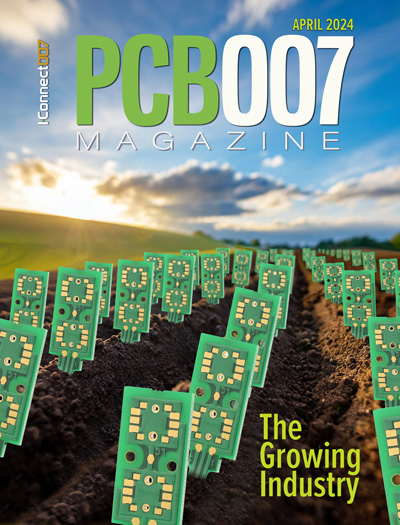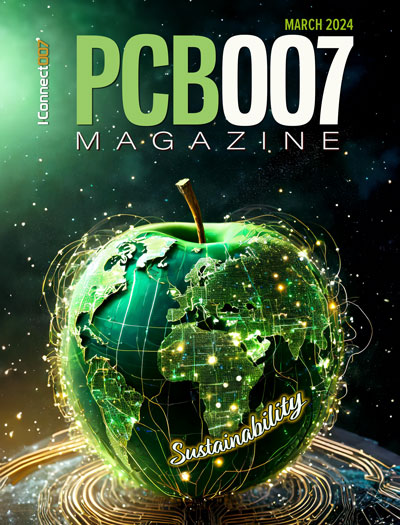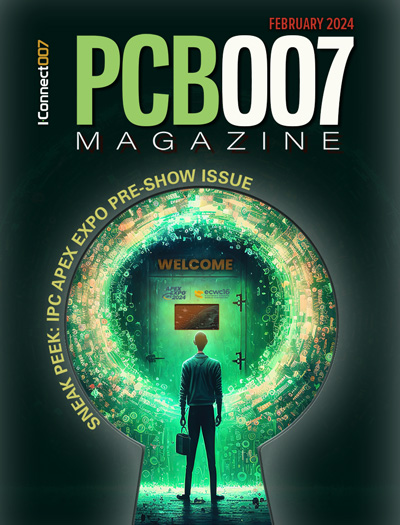-

- News
- Books
Featured Books
- pcb007 Magazine
Latest Issues
Current Issue
The Growing Industry
In this issue of PCB007 Magazine, we talk with leading economic experts, advocacy specialists in Washington, D.C., and PCB company leadership to get a well-rounded picture of what’s happening in the industry today. Don’t miss it.

The Sustainability Issue
Sustainability is one of the most widely used terms in business today, especially for electronics and manufacturing but what does it mean to you? We explore the environmental, business, and economic impacts.

The Fabricator’s Guide to IPC APEX EXPO
This issue previews many of the important events taking place at this year's show and highlights some changes and opportunities. So, buckle up. We are counting down to IPC APEX EXPO 2024.
- Articles
- Columns
Search Console
- Links
- Events
||| MENU - pcb007 Magazine
Is IPC the Past or the Future of our Industry?
January 28, 2016 | Jason Marsh, InsulectroEstimated reading time: 1 minute
In the electronics industry, there seems to be an infinite number of trade organizations, each with their own special niche and purpose. It can be challenging from the outside to understand why they each exist and how they fit together. First there is the alphabet soup of trade shows including IPC APEX EXPO, CPCA, HKPCA, JPCA, TPCA, DesignCon, productronica, IEEE Microwave, IMAPS, NEPCON, Meptec, Flex, Semicon West, CES, CEDIA, OE-A, MD&M, IDTechX and SMTA, to name a few. Then behind these trade shows there are the trade organizations that are the representatives of their respective technology niches such as IPC, CEA, NAMM, SMTA and IEEE. From a bare board fabricator and assembly perspective, the primary trade organization has historically been IPC. We look to IPC to take a lead in fostering our market, developing economically viable methods of standardization, and helping to bring suppliers and customers together.
For those of us manufacturing PCBs, assembling electronics or supplying the bare board industry, IPC is the steward of our industry and interests. For those of us who have been around for long enough, there is a good chance you have at some point experienced frustration with IPC and its mission or effectiveness at supporting our industry. Over the past decade and a half, North American fabricators have watched significant volumes of work transition from the U.S. to China. At the same time, operating costs have increased, EPA controls have tightened, and fabricators have been saddled with costly compliance requirements like Dodd Frank Section 1502 around conflict minerals, all of which add cost to U.S. operations, while the protection from overseas competition continues to be eroded.
Read the full article here.
Editor's Note: This article originally appeared in the December 2015 issue of The PCB Magazine.
Suggested Items
Warm Windows and Streamlined Skin Patches – IDTechEx Explores Flexible and Printed Electronics
04/26/2024 | IDTechExFlexible and printed electronics can be integrated into cars and homes to create modern aesthetics that are beneficial and easy to use. From luminous car controls to food labels that communicate the quality of food, the uses of this technology are endless and can upgrade many areas of everyday life.
Book Excerpt: The Printed Circuit Assembler’s Guide to... Factory Analytics
04/24/2024 | I-Connect007 Editorial TeamIn our fast-changing, deeply competitive, and margin-tight industry, factory analytics can be the key to unlocking untapped improvements to guarantee a thriving business. On top of that, electronics manufacturers are facing a tremendous burden to do more with less. If you don't already have a copy of this book, what follows is an excerpt from the introduction chapter of 'The Printed Circuit Assembler’s Guide to... Factory Analytics: Unlocking Efficiency Through Data Insights' to whet your appetite.
Listen Up! The Intricacies of PCB Drilling Detailed in New Podcast Episode
04/25/2024 | I-Connect007In episode 5 of the podcast series, On the Line With: Designing for Reality, Nolan Johnson and Matt Stevenson continue down the manufacturing process, this time focusing on the post-lamination drilling process for PCBs. Matt and Nolan delve into the intricacies of the PCB drilling process, highlighting the importance of hole quality, drill parameters, and design optimization to ensure smooth manufacturing. The conversation covers topics such as drill bit sizes, aspect ratios, vias, challenges in drilling, and ways to enhance efficiency in the drilling department.
Elevating PCB Design Engineering With IPC Programs
04/24/2024 | Cory Blaylock, IPCIn a monumental stride for the electronics manufacturing industry, IPC has successfully championed the recognition of the PCB Design Engineer as an official occupation by the U.S. Department of Labor (DOL). This pivotal achievement not only underscores the critical role of PCB design engineers within the technology landscape, but also marks the beginning of a transformative journey toward nurturing a robust, skilled workforce ready to propel our industry into the future.
Winner of The Science Show Rakett 69 Receives Incap Scholarship
04/24/2024 | IncapThe winner of the Rakett 69 science show, Andri Türkson, who stood out as an electronics enthusiast, received a scholarship from Incap Estonia, along with an internship opportunity in Saaremaa.


